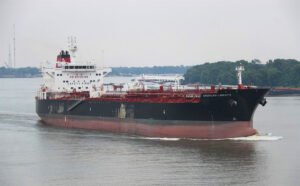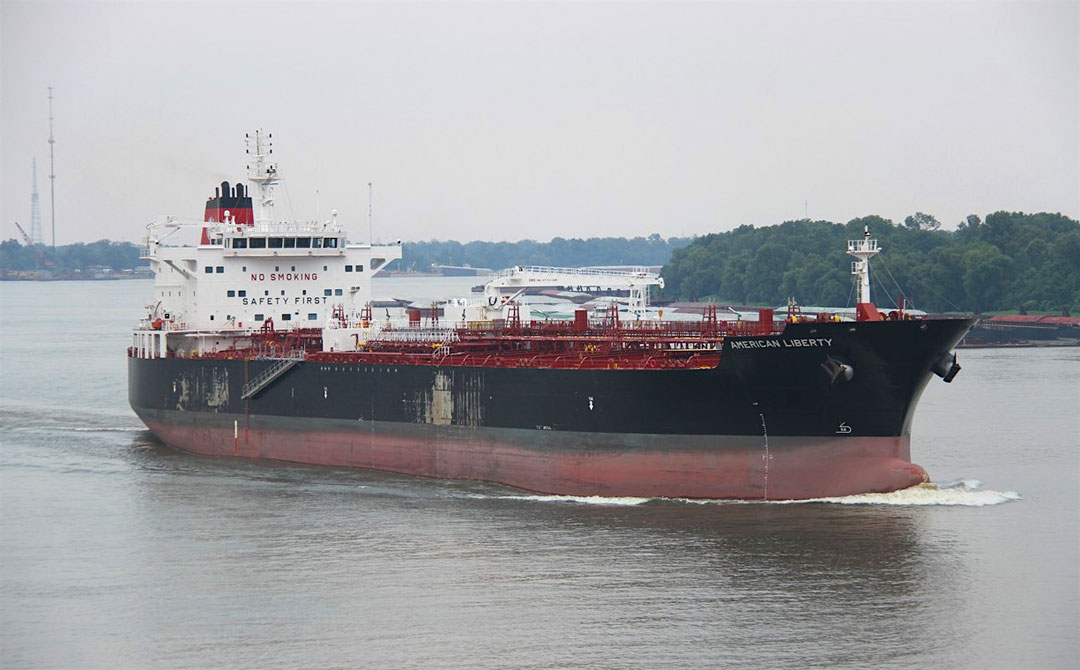American Liberty eased off the dock at the Marathon Oil terminal near Reserve, La., and began to spin 180 degrees in the flooded Mississippi River. Before long, the loaded tanker was drifting in the fast-moving current.

The master misunderstood a crucial engine order and later second-guessed the pilot as he tried to bring the ship under control. As the situation became more urgent, the master issued his own engine and rudder commands. The bridge crew began ignoring the pilot’s orders altogether.
At one point, the pilot repeated a full-astern engine order, National Transportation Safety Board (NTSB) investigators wrote in their accident report. The master countered with a request of his own. “Full ahead, don’t listen to the pilot,” he said.
Less than two minutes later, the 601-foot U.S.-flagged ship hit the first of several moored vessels and terminal infrastructure along the left descending bank. Total damage exceeded $40 million and four mariners were injured, one seriously.
The NTSB identified multiple factors leading to the incident, which occurred at 2042 on May 16, 2019 at mile 139.5. The agency noted poor bridge resource management and miscommunication between the master and the pilot on board from the Associated Federal Pilots and Docking Masters of Louisiana.
Those failures, the report said, “led to the bridge team’s delay in carrying out an engine order and caused a delay in the vessel attaining sufficient speed to conduct an undocking maneuver in high river conditions. Contributing to the accident was the decision to release the assisting tugs before the undocking maneuver was completed.”
The pilots group did not respond to inquiries seeking comment on the NTSB findings. Crowley, which manages American Liberty for American Petroleum Tankers, declined to comment.
American Liberty, delivered in 2017 by Philly Shipyard, is one of the newest tankers working the Jones Act trade. The Mississippi River was at major flood stage and its current around Reserve exceeded 5 knots at the time of the incident. The tanker was docked starboard side to the terminal, with its bow facing upriver.
The ship loaded a cargo of gasoline and low sulfur diesel from Marathon Petroleum Garyville for delivery to Tampa Bay, Fla. There were 23 crew on board when the ship got underway at 2028 on the clear, calm spring night.
American Liberty’s master and pilot agreed on a plan to work the ship off the terminal and spin it for departure. The tugboats Josephine Anne and Vera Bisso would help swing the ship around. The master and pilot later told investigators they understood the general undocking plan but acknowledged it was not comprehensive.
By 2033, American Liberty’s stern was clear of dockside obstructions as the ship began its turn. Within a minute, the turn was about two-thirds complete. The pilot released the 4,200-hp Vera Bisso that was pushing the ship around from the port quarter. A minute later, the pilot asked the master for slow ahead on the main engine.
“Bring her up to slow (ahead) … whenever you can,” the pilot said. The master responded, “Yeah, we’re probably going to need a little while, especially (with the current).”
The third mate operating the engine order telegraph heard the order but did not interpret it as a command, the NTSB said. Thirty-two seconds elapsed before the master walked to the engine order telegraph and set the speed to slow ahead as the pilot requested.
Meanwhile, the ship moved downriver at about 2.3 knots roughly parallel to the left bank, with its stern closer to the bank and the bow facing across the river. The pilot asked for “whatever you can give me” from the master, who placed the engine at half ahead without telling the pilot. The pilot ordered the 4,000-hp Josephine Anne to push full on the port bow at 2037 before calling on the tug to stop and fall back. The master disagreed, saying the tugs should continue pushing the ship around.
Less than a minute later, the pilot ordered the engine stopped and additional assistance from the two tugs. The master countered with, “We need the engine; we need to go.” Neither the mate nor master acknowledged the stop-engine order. Instead, the mate placed the engine at full ahead. Nobody told the pilot.
“The master told the pilot to speed up to break out of the current, but the pilot responded that he didn’t believe he could get enough speed and instead intended to go astern,” NTSB investigators said.
“At 2039, the pilot ordered engine full ahead and the mate replied that they were already at full ahead,” the report said. “At 2039:08, the master ordered rudder hard left. The pilot counter-ordered rudder hard right.”
The ship continued along the left bank and cleared the moored articulated tug-barge Teresa-Acadia and the tugboat Miss Caroline. The proximity to terminal infrastructure and the moored vessels precluded Josephine Anne and Vera Bisso from taking position on the port side of the tanker. Meanwhile, the master and pilot continued the tug of war over control of the ship. At 2040, the master ordered the mate and helmsman to stop listening to the pilot.
The master effectively had the conn at 2042 when American Liberty’s port quarter hit the crane barge Don D., which was moored with a hopper barge outside of the bulk carrier African Griffon. At 2043, the master ordered the starboard anchor let go and the engine room evacuated. Two minutes later, American Liberty struck the port bow of the bulk carrier Ever Grace and mooring equipment at the ADM Reserve elevator terminal. At 2051, the tanker hit three strings of hopper barges that broke loose. Eight minutes later, American Liberty damaged mooring dolphins and a catwalk at the PSL Upper Globalplex Reserve wharf, where the ship was ultimately tied up.
American Liberty required nearly $1.7 million in hull repairs, while Ever Grace and African Griffon each sustained less than $100,000 in damage. Don D. cost more than $500,000 to repair, while 11 ADM hopper barges sustained $221,000 in damage. Repairs to the ADM Reserve elevator terminal exceeded $32 million, while the PSL Upper Globalplex needed almost $6 million in repairs.
Four mariners aboard African Griffon and Don D. suffered injuries during the incident. The stevedore production manager aboard African Griffon, who recorded the incident on his cellphone when nearby wires split, suffered two skull fractures, the NTSB said.
Both the master and pilot on American Liberty were relatively new to their positions. The master had 13 years of maritime experience, but only 18 months as master on the tanker. The pilot was still in his probationary period and had worked alone for 10 months. He spent 18 previous years navigating large tows on inland waterways.
Investigators highlighted the imprecise communication between the master and pilot that began as American Liberty came out of its turn. Until then, the report noted, the pilot’s orders were precisely given and executed as expected. His order to increase the engine speed “whenever you can” was ambiguous; so was the request to “give me whatever you can give me.”
The pilot, who like the master was not identified, said he preferred to ask for speed changes rather than issue orders or commands because it was more polite that way.
“The pilot’s situation awareness was further diminished when the master changed the EOT (engine order telegraph) four times without informing him, so he continued to give engine orders without knowing what the EOT was set at,” the report said. “A pilot cannot be expected to successfully maneuver a vessel if their orders are not being followed or contrary orders are being executed without their knowledge.”
Casey Conley

